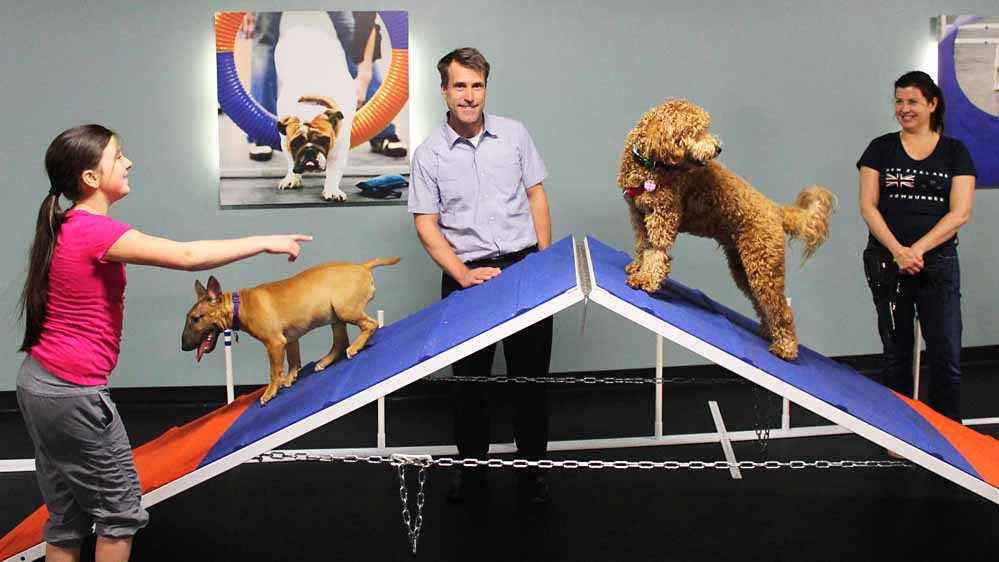Dog Training Near Me: Creating the Perfect Training Schedule
Wiki Article
Efficient Approaches for Successful Dog Training: A Comprehensive Guide
Effective pet training calls for a nuanced understanding of canine actions. It rests on the principles of positive reinforcement and consistency. Trainers must recognize the importance of necessary commands and socializing. Dealing with common behavioral issues can transform a canine's disposition. As the bond in between proprietor and canine strengthens, the way they connect develops. The journey of successful training incorporates various strategies that might surprise even experienced animal owners. What are the crucial elements that can make a considerable difference?Understanding Canine Behavior
Recognizing canine behavior is vital for efficient canine training, as it permits instructors to analyze a canine's actions and responses in different circumstances. Canines communicate largely via body language, vocalizations, and faces. Recognizing signs of anxiety, aggression, or anxiety can aid fitness instructors adjust their techniques to guarantee a favorable training experience. For instance, a wagging tail does not always suggest joy; the context and other body signs must be taken into consideration.Additionally, comprehending a pet's breed-specific characteristics can supply understandings right into their behavior patterns and impulses. Socializing plays a vital duty in shaping a dog's responses to new individuals and settings. Observing a canine's play design can also disclose their temperament and comfort degrees. By carefully reviewing these behaviors, trainers can produce customized techniques that promote discovering and strengthen the bond in between pet dog and proprietor, ultimately leading to more successful training results.
The Significance of Positive Support
Positive support is an essential strategy in canine training that enhances the discovering process by satisfying wanted habits. This technique encourages dogs to duplicate actions that yield favorable end results, such as deals with, appreciation, or playtime (Dog Training Near Me). By connecting etiquette with rewards, pets come to be extra motivated and engaged during training sessions
Including positive support right into training regimens can cause quicker learning and much better retention of commands. It advertises a cheerful environment that boosts both the pet dog's experience and the trainer's fulfillment, making it an essential aspect of effective pet dog training.
Crucial Commands Every Canine Need To Know

Developing a Constant Training Schedule
Developing a regular training timetable is essential for reliable dog training, as it helps reinforce knowing and develops a feeling of regular for the pet dog. A structured approach enables both the pet and the instructor to prepare for training sessions, which can boost emphasis and interaction. Preferably, training sessions must be short, lasting in between 5 to 15 minutes, to preserve the dog's interest and interest.Incorporating training into day-to-day activities, such as mealtime or strolls, can also advertise uniformity. This integration aids canines link training with positive experiences. It is essential for fitness instructors to remain adaptable; unforeseen occasions may demand adjustments to the timetable.
Additionally, repeating is key. Normal practice of actions and commands strengthens knowing and constructs self-confidence. By adhering to a constant timetable, fitness instructors can assure that their canines create good practices and react dependably to commands, laying the foundation for efficient training end results.
Socializing: Key to a Well-Adjusted Canine
Socializing is important for a pet's development, influencing their behavior and communications with people and other pets. Very early direct exposure to various environments, seems, and experiences can considerably improve a pet dog's flexibility and confidence. Utilizing efficient socializing methods can assist ensure a well-adjusted canine friend.Relevance of Very Early Socializing

Techniques for Effective Socialization
While lots of pet proprietors recognize the significance of socialization, understanding effective techniques to facilitate this process is crucial for cultivating a well-adjusted pet dog. Gradual direct exposure to varied atmospheres, individuals, and various other animals can significantly enhance a pet's convenience degree in different circumstances. Favorable reinforcement plays an important role; satisfying wanted behaviors urges pets to come close to new experiences with confidence. Structured playdates with courteous pet dogs aid create social skills and alleviate worry reactions. Registering in obedience courses can likewise give controlled settings for socialization. Lastly, maintaining a tranquil demeanor as an owner reinforces the dog's feeling of safety and security, permitting more successful interactions. These methods jointly add to a balanced and versatile canine friend.Taking Care Of Common Behavioral Issues
Handling usual behavior problems is essential for preserving an unified relationship between pet dogs and their proprietors. Key difficulties such as hostility, too much barking, and leaping behavior require targeted methods to take care of effectively. Comprehending the origin of these behaviors can result in successful treatments and a much more well balanced canine buddy.
Dealing With Hostility Issues
Aggression in canines can materialize in numerous kinds, posturing obstacles for instructors and proprietors alike. Resolving these issues necessitates a complete understanding of the underlying causes, which may include go to website territoriality, resource, or fear securing. Recognizing triggers is crucial; proprietors need to observe their canine's body language and actions to determine specific situations that provoke aggressiveness. Positive reinforcement strategies can successfully modify hostile behavior, gratifying calm actions to determined triggers. Consistency is vital, and owners have to stay person throughout the training procedure. In some cases, professional assistance from a licensed pet instructor or behaviorist might be called for, specifically for extreme hostility. Inevitably, the goal is to produce a risk-free atmosphere for both the canine and those around it.Taking Care Of Extreme Barking
Excessive barking can be a considerable nuisance for pet proprietors and next-door neighbors alike, frequently signaling underlying issues that need addressing. Identifying the triggers behind the barking is vital; these might consist of dullness, stress and anxiety, or a feedback to external stimuli. Proprietors ought to observe their dog's actions and setting to pinpoint the reason. Dog Training Near Me. Executing regular training methods, such as positive reinforcement, can effectively minimize barking. Teaching commands like "peaceful" or rerouting the pet dog's attention at the minute of barking can be helpful. In addition, offering ample physical and psychological excitement through exercises and interactive playthings can ease boredom-related barking. In some cases, getting in touch with a specialist trainer or behaviorist might be necessary to create tailored strategies that resolve persistent barking concernsMinimizing Leaping Habits
Lots of pets display jumping habits, often as a way of expressing enjoyment or looking for focus from their proprietors and site visitors. This habits can be problematic, especially when it causes unintended injuries or discomfort for visitors. To minimize leaping, proprietors must initially stay calm and avoid compensating the actions with attention, as this can enhance it. Rather, they can educate an alternative behavior, such as resting, by rewarding the dog for continuing to be calm when a person methods. Consistency is crucial; all family participants should enforce the same guidelines. Additionally, training sessions must consist of interruptions to assist the dog learn to control their impulses. Over time, with perseverance and persistence, leaping can be considerably decreased, causing a more enjoyable environment.Constructing a Solid Bond Through Educating
Although educating a canine typically concentrates on behaviors and commands, it also works as an important opportunity to strengthen the bond in between the pet dog and its owner. Participating in training sessions promotes communication, good understanding, and count on. When proprietors spend time in instructing their explanation pets, they show commitment, which aids the dog really feel protected and valued. Positive support techniques, such as deals with and appreciation, not just motivate wanted habits yet also strengthen the psychological link in between the canine and owner.In addition, uniformity in training builds a feeling of dependability, enabling pets to comprehend their duty within the family. Each effective command increases the canine's confidence, resulting in a much deeper partnership. Regular training sessions can end up being pleasurable bonding experiences, full of playfulness and communication - Dog Training Near Me. Ultimately, the process of training goes beyond simple obedience, developing a collaboration that enriches the lives of both the pet dog and its owner
Often Asked Questions
What Age Is Finest to Begin Educating a Puppy?
The best age to begin educating a young puppy is commonly between 8 to 12 weeks. At this stage, puppies are most responsive to discovering, making it an ideal time for foundational training and socialization.
For how long Should Each Educating Session Last?
The suitable period for every dog training session usually varies from 5 to 15 minutes, depending upon the canine's age and attention span. Short, focused sessions improve discovering and retention, making training much more efficient and satisfying.Can Older Dogs Still Be Educated Efficiently?
Older canines can indeed be trained efficiently. With patience and regular strategies, they can discover brand-new commands and behaviors. Their experience commonly makes them a view it lot more responsive to training, boosting the bond in between pet dog and proprietor.What Equipment Do I Required for Training?
For reliable pet training, crucial devices includes a tough chain, a comfortable harness, high-value treats, training remote controls, and a selection of playthings. These tools assist in communication and enhance positive behaviors throughout training sessions.How Do I Track My Canine's Training Progress?
To track a pet dog's training progress, one can keep a journal, document milestones, and note behavior modifications. Normal analyses, consisting of timed commands and obedience tests, assistance evaluate improvement and identify areas requiring additional focus.Recognizing canine actions is essential for reliable pet training, as it allows trainers to interpret a pet dog's activities and responses in various situations. Establishing a consistent training schedule is crucial for reliable pet dog training, as it aids enhance knowing and develops a sense of regular for the canine. Training a pet dog commonly focuses on habits and commands, it also serves as an essential chance to strengthen the bond between the pet dog and its owner. When proprietors invest time in showing their dogs, they demonstrate dedication, which aids the pet feel safe and valued. The ideal period for each pet training session usually ranges from 5 to 15 mins, depending on the pet's age and focus period.
Report this wiki page